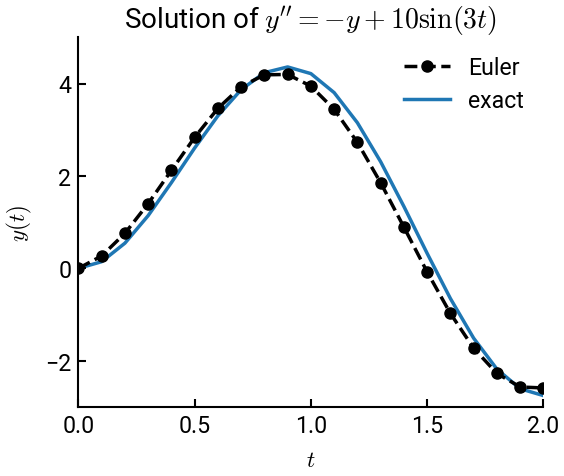Example 11-4: Backward Euler#
Now that we’ve spent some time looking at forward Euler, it’s time to introduce backward Euler. This algorithm is essentially the same as forward Euler, but now \(y_{n+1}\) appears on both sides of the finite difference approximation. As such, this falls under the class of implicit schemes.
Summary of commands#
No new commands are demonstrated in this exercise.
Backward Euler demo#
Consider the same IVP that we saw in Example 11-12:
\[ y' = -y + 10 \sin(3t), \quad y(0) = 0, \quad 0 \le t \le 2 \]
The exact solution is \(y = -3 \cos (3t) + \sin (3t) + 3e^{-t}\).
We’ll numerically solve this ODE using backward Euler and a step size of \(h = 0.1\).
# import libraries
import numpy as np
import matplotlib.pyplot as plt
# initialization
h = 0.1
t0 = 0
tf = 2
y0 = 0
y = [y0]
t = [t0]
# backward Euler loop
n = 0
while t[n] < tf:
t.append(t[n] + h)
y.append((y[n] + 10 * h * np.sin(3 * t[n + 1])) / (1 + h))
n += 1
# exact solution
t = np.array(t)
y_exact = -3 * np.cos(3 * t) + np.sin(3 * t) + 3 * np.exp(-t)
# plot result
fig, ax = plt.subplots()
ax.plot(t, y, 'k--o', lw=2.5, label='Euler')
ax.plot(t, y_exact, lw=2.5, label='exact', zorder=-5)
ax.set(xlabel='$t$', ylabel='$y(t)$', title=r"Solution of $y'' = -y + 10 \sin(3t)$",
xlim=[0, tf], ylim=[-3, 5])
ax.legend()
plt.show()


